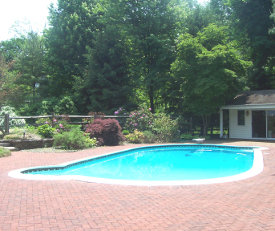 |
| Source: ptadesign (Flickr) |
There are other reasons to avoid using pool chemicals, but you get the point. There's keen interest among many would-be pool owners in finding an alternative to the usual method of pool sanitation. Here are a few of the most popular options.
Natural Pools
Already popular in Europe, natural swimming pools are catching on in the United States as well. These manmade swimming holes feature their own ecosystems that keep the water sanitary through plant filtration rather than chemical treatment. While they might seem radical, they can actually be designed to look much like a conventional swimming pool. The plants are usually separated from the swimming area by some sort of barrier, and a pump can be installed to keep the water from growing stagnant. Maintenance is much cheaper and simpler, as these sorts of pools simply do what comes naturally.
Saltwater Pools
Saltwater pools are another trendy topic among pool people. Technically, these pools are not chlorine-free - they contain chlorine as well, but they produce it by breaking down salt via a chlorinator. The advantage is that you don't have to handle or store chlorine on your property. Plus, water chlorinated this way tends to not be as harsh on skin and eyes. On the downside, maintaining the proper salt level can be tricky and you could risk corroding fixtures if you don't get the balance right.
Other Options
If being eco-friendly is your main concern, then a natural pool is the clear choice. However, if your desire to avoid chemicals is based purely on convenience, there are a couple of other options worth mentioning. One is to get a fiberglass pool, which has an algae-resistant surface and therefore requires less maintenance. The other option is painfully obvious - hire a pool service to maintain your pool chemistry for you.As you can see, there's no perfect solution for those who want a pool but hate the thought of dealing with pool chemicals. These alternative water treatment options all come with their own tradeoffs. However, if you weigh the pros and cons, you might well find - like many other pool owners - that a natural or saltwater pool is a more attractive choice than chlorine.






